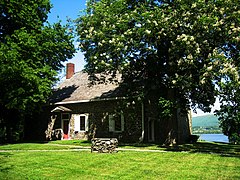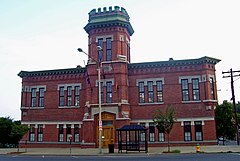East End Historic District (Newburgh, New York)
East End Historic District | |
Gothic Revival | |
| NRHP reference No. | 85002426 |
|---|---|
| Added to NRHP | 1985 |
The East End Historic District in
This area includes much of the southeastern quarter of the city. Most of the buildings were constructed during the city's height of industrial development in the later 19th century, as opposed to the villas and mansions in the Montgomery-Grand-Liberty district. They housed many of the city's working-class population at the time, and the small businesses that served them. First recognized by the city in 1973, it was added to the National Register of Historic Places in 1985.
Today, it is a mix of extremes. Some of its neighborhoods are among the city's most desirable, offering panoramic views of the
Geography
The district is roughly bounded by Robinson Avenue (US 9W) to the west, Water Street and Bay View Terrace on the east, Monument and Renwick streets to the south and LeRoy Place and Broadway to the north. This area of Newburgh, combined with the other district, represents the core of the settled city by the end of the 19th century.[2] It rises up gently from the riverside area to mildly rolling higher ground.
Industrial properties, both vacant and in use, are concentrated closer to the river, while the higher neighborhoods are mostly residential, with some institutional buildings such as schools and churches scattered throughout. There are a few commercial areas, most notably along Liberty Street opposite Washington's Headquarters, taking advantage of tourist business at the historic site during the summer months; along Broadway near City Hall and also along a short block of William Street further south.
Combined and treated as one district, the 4,000 contributing properties are the most of any historic district in New York.[3] The 2,239 resources in the East End alone are the most of any federally recognized district in the state.[4]
Architecture
Much of the district is characterized by two- or three-story brick townhouses in the Italianate style popular in the late 19th century for urban buildings. In Washington Heights, the blocks near the southeastern corner of the district, where views of the river open up, there are houses in many Victorian styles reflecting the rapid subdivision and development of that area between 1886 and 1900.[2]
The houses on and near Parmenter Street, one block west of Washington's Headquarters, are the only part of Newburgh that still reflects the village character of the settlement from the turn of the 19th century. Houses here are
Significant contributing properties
The oldest property in the district and the city, Jonathan Hasbrouck's 1750 stone house, is today the center of
-
Hasbrouck House at Washington's Headquarters
-
The armory in 2007
-
Urban blighton two abandoned houses not far from the Armory.
Preservation issues
The city has recognized the historic district in its zoning, required architectural review of any significant construction within it, and initiated and encouraged many efforts to redevelop portions of it. Many properties remain abandoned and neglected, and in 1996 the
In April 2017 a $15 million "scattered site" development project using a combination of state/federal Low Income Housing and Historic Tax Credits was underway. "The Newburgh Core Revitalization Project" by Kingston-based not for profit RUPCO in cooperation with The Newburgh Community Land Bank will restore 15 buildings and transform the properties into 45 affordable rental apartments to assist middle income families, artists, veterans and the homeless. The revitalization project is expected to be completed by Sept. 2018, with first tenants arriving in late 2017. http://spectrumlocalnews.com/nys/hudson-valley/news/2017/04/7/rupco-begins--15-million-core-revitalization-project-in-the-city-of-newburgh
See also
References
- KiB), retrieved January 5, 2008.
- ^ a b c Larson, Neil; Mark Peckham (August 1985). "National Register of Historic Places application, East End Historic District". Retrieved January 5, 2008.
- ^ "Newburgh Revealed". Retrieved January 5, 2008.
- ^ Lee, Denny (May 21, 2004). "HAVENS; A River Runs Through Them". The New York Times. Retrieved January 5, 2008.
- ^ "PARKS COMMISSIONER ANNOUNCES HISTORIC PRESERVATION AWARDS" (Press release). New York State Office of Parks, Recreation and Historic Preservation. May 7, 1998. Retrieved September 4, 2007.
Through the vision and hard work of the Gemma Development Company of Hicksville and Central Valley, New York, the armory has been reborn. The private development company has transformed an eyesore, that many felt should be torn down, to a revitalized landmark with a new lease on life—the results could not be more dramatic. The building's distinguished brick and stone exterior has been repaired and its interior has been converted to municipal offices for Orange County
- ^ "11 Most Endangered Places, East End Historic District". May 2007. Retrieved January 5, 2008.
- ^ "Portion of the East End Historic District (Newburgh)". November 20, 1999. Archived from the original on September 28, 2007. Retrieved January 5, 2008.
External links
 Media related to East End Historic District (Newburgh, New York) at Wikimedia Commons
Media related to East End Historic District (Newburgh, New York) at Wikimedia Commons





